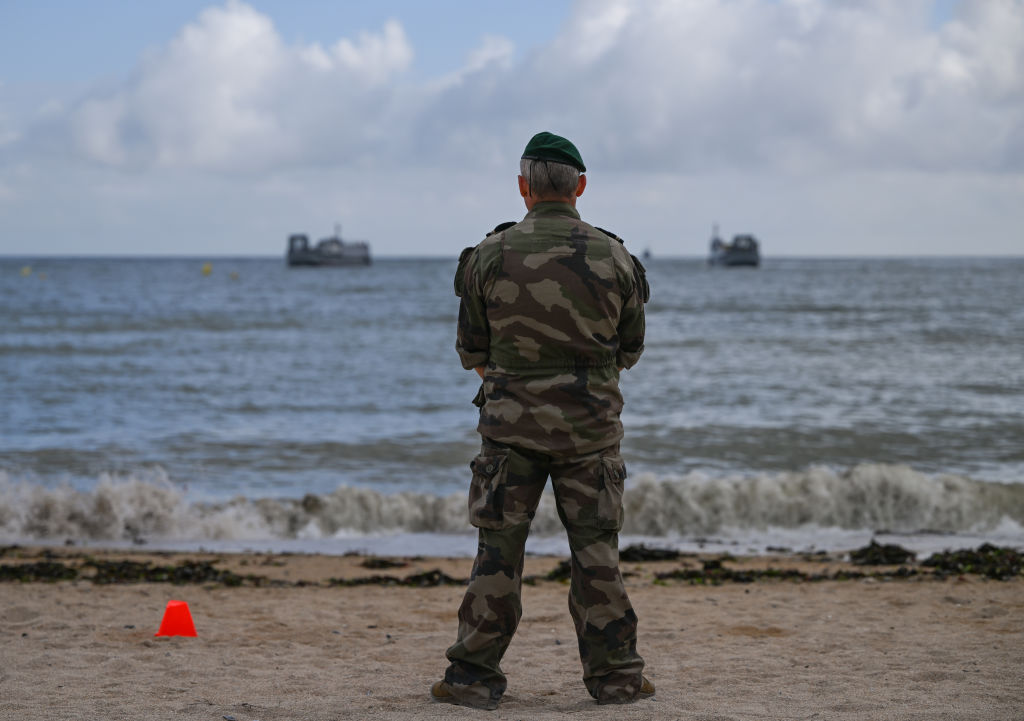By James C. Roberts
Today, Allied leaders from World War II are gathering on the beaches of Normandy in northern France to commemorate the 80th anniversary of the greatest seaborne invasion in military history: Operation Overlord or, as we have come to know it, D-Day.
On this day, Allied forces gained a foothold on the European continent that led, 11 months later, to the defeat of Nazi Germany and the odious regime of Adolf Hitler, who was responsible for the death of 20 million people.
Eighty years later, the scope, complexity, and sheer audacity of the operation inspire awe. Involved were dozens of gliders, thousands of paratroopers, 11,000 aircraft, 7,000 ships and landing craft, manned by 195,000 naval personnel and a landing force of almost 160,000 soldiers and marines.
 By evening, this landing force (mainly from the United States and British Commonwealth countries) was ashore and, despite 10,000 men being killed and wounded, the operation was a success. That it succeeded is little short of miraculous, given the obstacles that had to be overcome. For starters, Hitler had ordered the construction of the Atlantic Wall along the coast of Europe and fortified by hundreds of pillboxes and bunkers housing thousands of anti-tank weapons, heavy artillery, and machine guns, the placement of thousands of underwater obstacles and 6.5 million naval mines. Stationed in northern France, the Nazis also had 50,000 troops manning 1,400 tanks and were equipped with vast supplies of equipment and weaponry.
By evening, this landing force (mainly from the United States and British Commonwealth countries) was ashore and, despite 10,000 men being killed and wounded, the operation was a success. That it succeeded is little short of miraculous, given the obstacles that had to be overcome. For starters, Hitler had ordered the construction of the Atlantic Wall along the coast of Europe and fortified by hundreds of pillboxes and bunkers housing thousands of anti-tank weapons, heavy artillery, and machine guns, the placement of thousands of underwater obstacles and 6.5 million naval mines. Stationed in northern France, the Nazis also had 50,000 troops manning 1,400 tanks and were equipped with vast supplies of equipment and weaponry.
Another huge challenge was the weather in the English Channel, which was especially fickle at that time of year, with storms, heavy fog, and turbulent waves common. Moreover, there were only a few days that June on which the tides were favorable for landings.
On the plus side, the Allies, under the command of Gen. Dwight D. Eisenhower, displayed a model of cooperation, creating a unified command that functioned seamlessly. Despite the many nationalities involved in the coalition, not a single piece of significant classified information leaked out.
Moreover, the Allies created one of the most incredible feats of trickery in the history of warfare. The Germans were logically convinced that the invasion would come at the Pas de Calais, where the English Channel was at its narrowest — a mere 20 miles. The Allies reinforced this misconception by constructing an enormous phantom army base inland on the English side, filled with hundreds of inflatable tanks and other military vehicles. Moreover, the Allies made it clear that the commanding officer of this phantom army was Gen. George Patton — the general the Germans feared most — thereby compounding the Germans’ belief that the army was real. Because of this deception, the Germans concentrated their seven Panzer divisions and the majority of their military forces in northern France around the Pas de Calais. Had they known that the real landing area was in Normandy, the invasion almost certainly would have failed.
Eisenhower initially selected June 5 as D-Day, but turbulent weather forced cancellation of the invasion and the recall of the ships carrying the invasion force — men who had already been enclosed in cramped conditions for more than 24 hours. Many of these men were seasick and their combat ability was severely degraded. His official meteorologist, however, predicted a break in the weather for June 6, and on that basis Eisenhower gave his famous order, “OK, we’ll go.”
The weather continued to be rough, however, and as they neared the five landing beaches and the ramps of the landing craft went down, many of the GIs, burdened with heavy packs, drowned when they jumped into water over their heads.
As with many great military successes, luck played a role. The German command structure was highly centralized, and Hitler’s approval was necessary for major decisions, a fact that prevented rapid response to the invasion. In addition, Field Marshal Erwin Rommel, charged with the defense of northern France, believed that the bad weather meant an indefinite delay in the invasion plans and took leave to travel home to visit his wife. Moreover, Hitler had ordered that he not be awakened for any reason and, because of this, did not learn of the invasion until 10:00 in the morning, four hours after it had begun.
Upon notification, Rommel raced back to France, but he and Hitler believed that the Normandy operation was a feint to distract from the real landings, still predicted to come at the Pas de Calais. This belief delayed a counterattack by the main German forces by a full day.
The combination of these factors meant that the landings were successful; the landings on four of the five beaches — Sword and Gold (Britain), Juno (Canadian), and Utah (American) — went relatively smoothly. But resistance on Omaha Beach (American) was fierce, and the American troops involved suffered heavy casualties.
By evening on June 6, the invasion force of 160,000 men was ashore and could not be dislodged. Two million additional men would follow. Hard fighting continued in the Normandy region for a month, costing the Allies 73,000 dead and 153,000 wounded, but at length the Allies broke out and surged toward Germany. In less than a year, Hitler committed suicide and Germany surrendered.
Without the victory of D-Day, none of this would have been possible. Failure at Normandy would have meant the war prolonged for at least a year at a cost of thousands of additional Allied casualties.
Instead, victory at Normandy accelerated the end of the war, the liberation of more than 20 countries, and the ushering in of the American Century.




